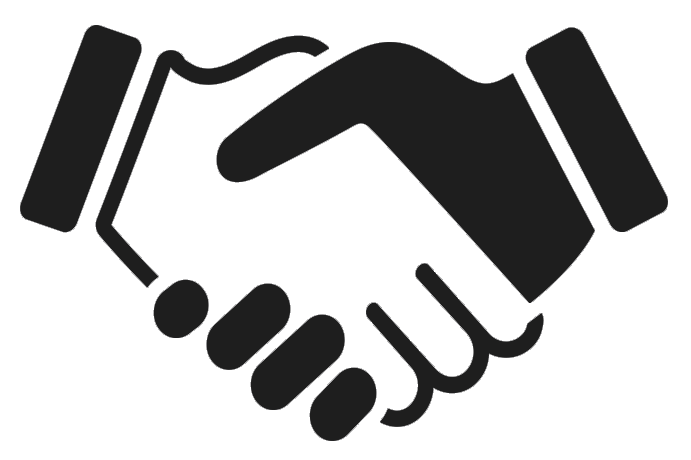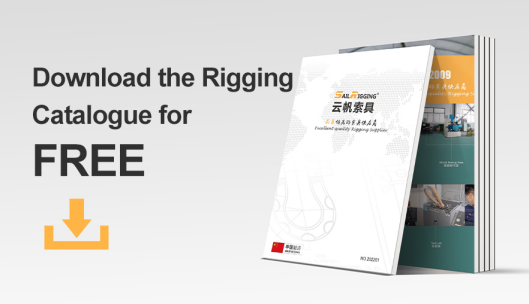What Is a Turnbuckle Used For, And How Can It Secure Your Rigging?
Have you encountered the problem that the wire rope is too long and cannot be tightened? Are you troubled by slack rope, uneven tension, etc.? Slack and uneven tension will affect the safety and efficiency of lifting and hoisting operations, but don’t worry, in fact, a reliable rigging solution can help you solve your pain points.
Table of Contents
Turnbuckles are the key to solving your pain points. Turnbuckles, also known as turnbuckles, rigging, and wire rope tensioners, adjust the tightness of the wire rope by rotating the main body, pulling in or out the accessories at both ends, tightening the slack part, and applying tension to the rigging components to achieve the bundling and tightening of the wire rope.
What are Turnbuckles Made Of?
Turnbuckles are generally made of carbon steel or stainless steel. Common carbon steels include low carbon steel Q235, high carbon steel No. 45 steel, etc., and stainless steels include 304\316. Whether it is a carbon steel turnbuckle or a stainless steel turnbuckle, both have heavy-duty performance and reliability. The difference between the two materials lies mainly in the degree of corrosion resistance. Stainless steel is more corrosion-resistant than hot-dip galvanized steel, making it an ideal choice for marine applications.
Different Types Of Turnbuckles
Turnbuckles come in a variety of types, sizes, materials and surfaces for straight-pull, in-line applications, and are suitable for a variety of hanging, tie-down and tensioning applications.
- Depending on the occasion, turnbuckles are divided into eye type, hook eye type, hook hook type, eye jaw type, jaw jaw type, etc. The ring type is suitable for occasions where it is not often disassembled, the hook hook type is suitable for occasions where it is often disassembled, and the eye hook type can meet the specific needs of frequent disassembly of one end and infrequent disassembly of the other end.
- Depending on the process, turnbuckles are divided into two types: casting and forging. Casting turnbuckles are suitable for static bundling and stabilization scenes, such as garden windbreaks and agricultural greenhouses; while forged turnbuckles are more suitable for lifting, freight bundling reinforcement and other occasions, such as cargo bundling in logistics, sling connections, and steel structure cable rod connectors.
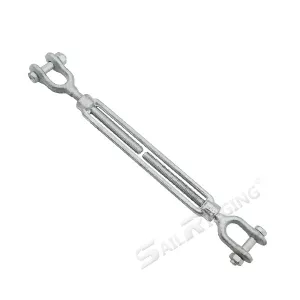
- Depending on the surface treatment, turnbuckles are divided into two methods: electroplating or hot-dip galvanizing, which aims to enhance its corrosion resistance and extend its service life. The electroplated surface is smoother and the cost is relatively low. Hot-dip turnbuckles have thicker coatings, are suitable for harsh environments, are more corrosion-resistant, and have a longer service life.
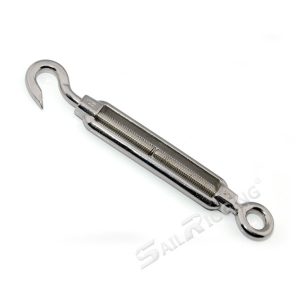
- According to different standards, turnbuckle screws are divided into American die-forged turnbuckles, DIN1480 turnbuckles, JIS open body turnbuckles, DIN1478 turnbuckles, Australian tube body turnbuckles, national standard turnbuckles, marine turnbuckles, etc. We can provide turnbuckles of different standards according to your needs.
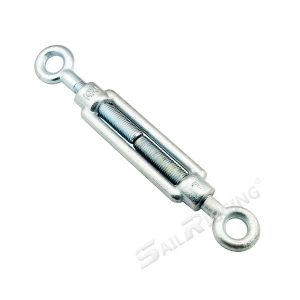
How to tighten the turnbuckle correctly?
Tightening the turnbuckle
Correctly tightening the turnbuckle is very important for tightening the wire rope. If it is tightened in the wrong direction, it will cause improper rigging tension, which will affect safety.
The two ends of the turnbuckle have different threads, “L” for left-hand thread and “R” for right-hand thread. One end is screwed into the turnbuckle body with right-hand thread and the other end is screwed into the left-hand thread. When you turn the turnbuckle body in one direction, both ends are pulled into the body at the same time. This shortens the overall length of the turnbuckle assembly, thereby tightening anything connected to it – whether it is a wire rope, a rod or a chain. Rotating the body in the opposite direction pushes the end out, lengthening the assembly and relaxing tension.
Understanding the Mechanism
- Reverse Threads: The key is that the turnbuckle body has right-hand internal threads on one end and left-hand internal threads on the other. The corresponding end fittings (eyebolts, claw bolts, hook bolts) have matching external threads.
- Body Rotation: When only the center body of the turnbuckle is rotated, the fittings on each end are either screwed further into the body (tightening) or further out of the body (loosening). From the perspective of the rotating body, the two threads are “advancing” or “backing out” at the same time because they are in opposite directions.
- No Twist in the Connecting Wire: A big advantage is that the connected cable or rod does not need to be twisted during adjustment, just the screw body needs to be rotated. Claw-end screws are particularly good at preventing twist in the connecting wire.
Tightening Steps
- Ensure Free Rotation: Make sure the threads are clean and lubricate if necessary to ensure smooth operation.
- Identify tightening direction: Typically, if you hold an end fitting and rotate the turnbuckle body, one direction will cause the body to “climb” along the threads of that end fitting toward the connecting line (tightening), while the other direction will cause the body to move outward (loosening). The easiest way to do this is to see if the overall length is decreasing.
- Use the right tools: For smaller turnbuckles, hand tightening is sufficient. For larger turnbuckles, a small bar (often called a “crowbar” or “lever bar”) can be inserted into a hole on the turnbuckle body to provide leverage. For some types of turnbuckles, a wrench can be used to tighten flat surfaces machined on the body or end fitting.
- Tighten evenly: Apply tension gradually. Check that the connected parts are aligned.
- Secure : Once the desired tension is achieved, some turnbuckles are equipped with locking nuts (lock nuts) on the threaded end fittings. These nuts should be tightened on the turnbuckle body to prevent it from accidentally rotating and losing tension due to vibration or load changes. This is important for safety and long-term stability.
Don’t tighten a turnbuckle over its safe working load. This will damage the turnbuckle or the components it connects to. PLS refer to the manufacturer’s specifications for load ratings or consult Sail Rigging product manager.
More Articles You May Like
Types And Application Of Rigging Hooks
How To Properly Use Safety Chains?
Questions
For any question on turnbuckles or our other lifting and rigging products, contact one of our product experts today!

